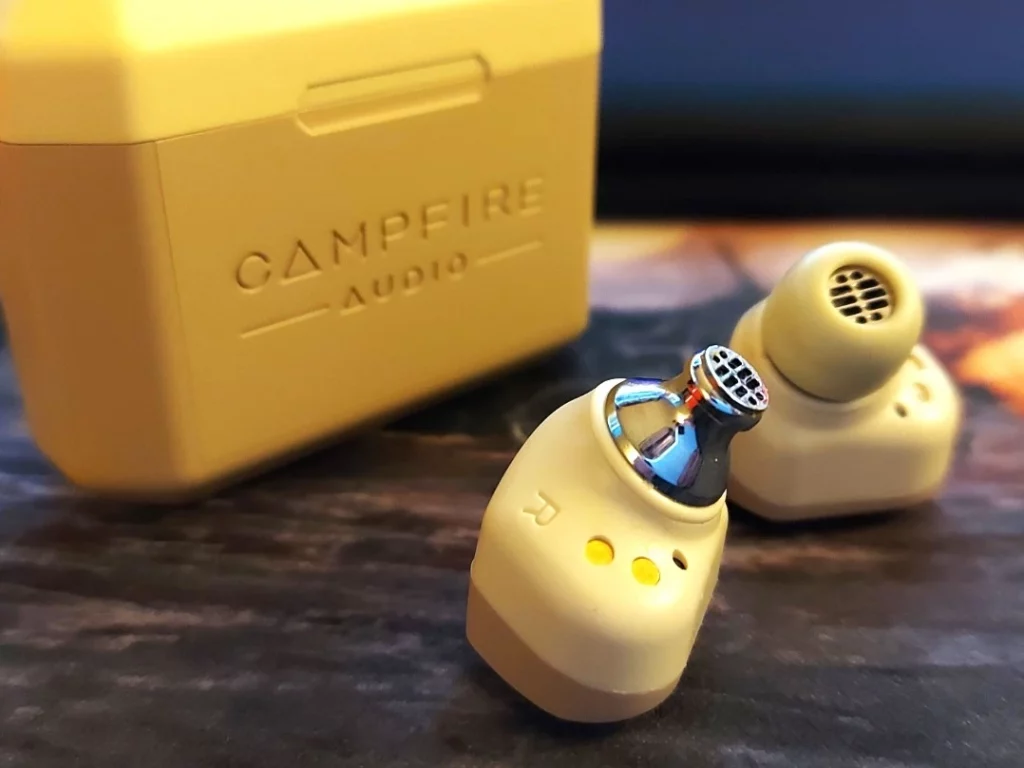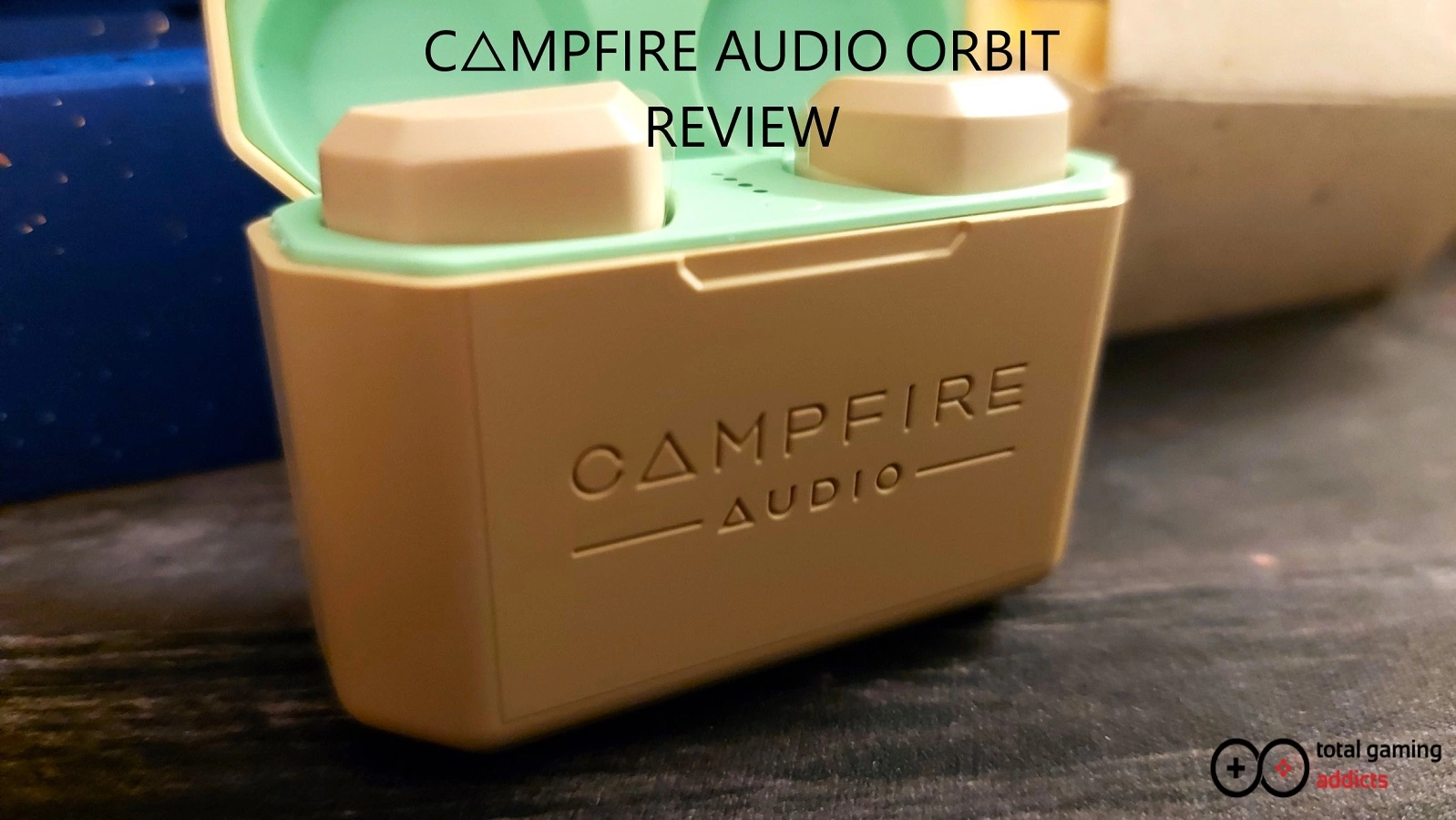The Campfire Audio Orbit has set a new benchmark for what we should expect from wireless earbuds
- Manufacturer: Campfire Audio
- Model: Orbit
- SKU: TWS-ORB
- Type: Bluetooth 5.2 True Wireless Earbuds
- Price: £249.99 MSRP
- Supported Connections: Bluetooth 5.2
- Reviewed on: Windows PC, Samsung Mobile/Tablet
- Supplied by: Campfire Audio

Campfire Audio Orbit True Wireless Earphones Review
Overview
Hailing from Portland, Oregon, Campfire Audio is renowned for its incredible range of audiophile-grade IEM (in-ear monitor) earphones, with a price point to match; If your pockets are deep enough, you can sink $3,375 into a pair of Campfire Trifecta IEMs, so it’s safe to say they know their way around portable audio. The Campfire Orbit which we have here is Campfire’s first foray into true wireless earbuds, and they’ve absolutely nailed it, but they’ve also brought them out for a very competitive price of £249.99.
Rather than focus on extra features like active noise cancellation or an ambient mode, the Orbit is laser-focused on the most important part, the sound. While some may lament the lack of ANC, the Orbit have superior passive noise cancellation, especially when using the incredibly comfortable memory foam tips. The excellent fit also plays dividends when it comes to the listening experience.
As you’d expect from Campfire Audio, the Orbit sound incredible, but everything about these earbuds is premium, from the styling and presentation to the class-leading battery life.
Design and build
What’s in the box?
- Orbit wireless earphones
- USB-C to USB-C charging cable
- Charging case
- Quick-start guide/user manual
- Campfire Audio pin-badge
- Memory foam and silicon tips (S/M/L)
Unless it’s an unusually impressive experience, I rarely mention the unboxing experience, but Campfire deserves special mention. The compact package is secured with a golden seal sticker, which when unpeeled allows the box to elegantly fan open, revealing a beautifully designed box with intricate design work.



Opening the box gives you your first glimpse of the stunning two-tone charging case, which echoes the palette of the earbuds. Nestled alongside the case is a cleverly designed box that opens to reveal the selection of tips, and underneath these is a hinged base containing the user manual, the (extremely short) charging cable, and your Campfire Audio lapel pin. The diminutive yet sturdy all-cardboard construction is vastly more impressive than an oversized box filled with plastic baggies of various accessories.


The earbuds and charging case are equally as impressive. In a market dominated by black and white earbuds, the natural-hued beige and light brown colourway is uniquely subtle. There is a splash of colour inside the case, with a minty green finish that compliments the earth tones of the buds and case, and whilst it may not be to everyone’s taste, I love it. I did find that the smooth finish of the earbuds combined with the close-fitting recess in the case and reasonably strong magnets made it a little tricky to remove the earbuds, but that’s a very minor complaint and I figured out the best way to grip them after a dozen or so goes.
Angular and bold, the Campfire Orbit are a distinctive pair of buds. The two-tone body is beautifully accentuated by the stainless steel spout and a golden metallic Campfire logo. They are slightly chunkier than something like the Airpods, but they don’t have a long stem dangling from your ear, and the body of the buds is carefully designed to optimise the sound quality, as well as housing the impressively long-life batteries.
Despite the size, these are very lightweight buds, which makes them very comfortable to wear for prolonged periods. They do have a slightly unusual fit, though. The stainless steel nozzle is quite wide, so they nestle in the opening of your ear canal, rather than shove right on in there. I used the memory foam tips, which give additional grip, and although I was worried they would fall out or come loose, my fears were unfounded. As long as you pick the right tips, the Orbit buds stay securely where you put them, and I had no issues with them becoming loose or losing the acoustic seal even during vigorous activity.
As I mentioned earlier, the snug but comfortable fit provides exceptional passive noise cancellation, which means you don’t have to crank up the volume to drown out background noise. This is where some form of ambient passthrough would have been useful, but it’s no big deal popping a bud out if you need to hear something around you.
Another welcome addition is IXP5 water resistance. You can’t submerge the Orbit underwater, but they’ll hold up perfectly well to gym sweat or a rain shower, which is very reassuring.

Features and controls
The Campfire Orbit use simple touch controls, and without ANC or ambient modes to facilitate, it’s very straightforward. A single tap on the left or right bud will play/pause audio, and double tapping the left or right bud will go to the previous or next track, respectively.
Long pressing the left or right bud will lower or raise the volume in reasonably large increments, but it’s not a press-and-hold adjustment so you have to make repeated presses for larger changes in volume; I found it much easier to adjust the volume via my phone or PC directly.
Triple-tapping will launch your voice assistant, for hands-free operation of your phone. You can also answer/hang up/reject incoming calls, but there’s no explanation of which combo of taps perform these operations.
There is no power on/off feature on the buds themselves. You’ll have to pop them back into the case when you’ve finished listening, but I was pleased to find you can use one bud at a time without needing to take them both out of the case.
An app is available for Android and iPhone users, showing you a percentage battery life for each earbud and letting you see the smart (tap) functions that are enabled. You can enable/disable the smart functions from within the app, which could be handy if you’re prone to accidentally pressing your buds.
There’s also an EQ customisation tool including some presets, but these are just numbered rather than using the traditional method of labelling them as pop, rock etc. You can create your own custom EQ with a 7-band equaliser, but I found the native audio tune essentially perfect for my preferences (powerful bass, prominent mids, and clean but not sharp treble).
Finally, the app has an option for firmware updates that could add extra features, however, there was no update available at the time of testing. Campfire has had requests to include an ambient/transparency mode, so it’s possible that this could be implemented via an update, but at present, the best we’ve got is a, “we’re looking into it”.

Connectivity
The initial pairing is very straightforward; opening the case for the first time puts the Orbit in pairing mode, and then you just select Orbit from your device’s Bluetooth menu. Once that’s done, they seamlessly reconnect to your phone when you remove them from the case. If you want to pair them with another device, a five-second press will manually activate pairing mode again. Unfortunately, the Orbit doesn’t support Bluetooth multi-point, but the buds are designed to be the perfect on-the-go companion rather than a multi-device workhorse.
The Bluetooth range is above average, reaching ten metres unobstructed, though obviously this may be reduced depending on your location.
Sound Quality
Design and build quality are certainly strong suits of Campfire Audio, but it’s the sonic performance you are paying for. When designing the Orbit earbuds, Campfire went to great lengths to ensure their signature sound came first and foremost, focusing on the acoustic chamber and drivers, and fitting the wireless components around them. The result is inarguably incredible.
The first thing I noticed when I tested the Orbit was the superior imaging of the sound. Although the soundstage is relatively wide, it’s the separation and placement of sound that the Orbit can achieve that wows. They can move the sound around you in a way I didn’t expect from an in-ear bud, bringing a very intimate and personal feel to music.
These are powerful earphones and can reach deafeningly loud volumes if you crank them up to the maximum. The beauty is, you don’t need to. I’ve mentioned the excellent passive noise isolation a few times, and with good reason. The sound produced by the Orbit remains rich and vibrant even at lower volumes, so you don’t need to turn them up to drown out background noise and can focus on enjoying your music.
If you do push the Orbit to full volume, there is a small amount of distortion, especially when listening to lower-quality mp3 songs, but I’d argue it’s intolerably loud at full whack anyway. Stick to a still-booming 80% volume and there is no distortion, just thundering bass, rich mids and crystal-clear treble.
Campfire has tuned the audio profile of the Orbit buds to have their “North of neutral” signature, with a strong emphasis on the low end. To my ear, it’s very reminiscent of what most EQ profiles would label as the Rock or Pop profile – bass is notably boosted, and treble gets a clear focus. If you favour a completely flat audio profile, then these probably aren’t the earphones for you.

The bass is possibly the most impressive element of the sound. The Orbit can drop down very low, producing deep and sustained bass notes that small drivers often struggle with, but it is the punch across the rest of the bass frequencies that is remarkable, with short and sharp notes pounding in a hugely impactful way. They never muddy the rest of the audio, though, leaving plenty of breathing room for the midrange and treble.
Much like the bass, the lower mids are wonderfully represented, which gives the sound a cosy warmth, but the native audio tune could do with being lifted ever so slightly in the higher midrange. It’s fantastic for music, but when listening to podcasts or TV shows at high volume there was a slight overemphasis on the deeper aspects of the speaker’s voice that wasn’t as natural as it should be (though the audio profile sounds far more neutral at around 30-40% volume). The flip side is this opens up space for the treble, and works supremely well for dance music and EDM. Essentially, the mid-tuning is going to be a matter of personal preference, but rest assured it can be remedied with minor tweaks to get it to your desired levels.
Treble is restrained in its delivery, but I found this helped over longer listening periods. When the treble is too sharp I find it becomes piercing after a while, but Campfire has balanced it beautifully with the Orbit. Higher notes retain their clarity, and it’s easy to pinpoint location. Importantly, the treble is always present in the mix, even amongst the thundering bass. Much like the mids, you may want to give the treble a lift in the EQ to balance the sound and bring a little more impact, but for my taste, it needed no change.
Considering these are running over Bluetooth the Orbit produces incredible sound. It’s the closest I’ve heard wireless buds come to a set of wired audiophile headphones, which is a remarkable achievement. Campfire’s signature audio profiling is front and centre, and the soundstage and imaging are exceptional. I can imagine most if not all people being very satisfied with the Orbit wireless earbuds.

Battery life
Once again, Campfire has produced a class-leading performance. The Orbit holds 8.5 hours of charge in the earphones (at 80% volume), with a further 30 hours charge available from the charging case. Real-world performance, however, exceeds this. I rarely needed to have my music above 60% volume, and for podcasts (my umpteenth listen-through of The Ricky Gervais Show), 30% volume was more than adequate.
With my usage, I never ran the buds down below 30%, even with a solid 8 hours of podcast playback (I even had to leave them on while not in use, just to test the battery). Considering most of the time I slip them back into the charging case, which is now always in my pocket, I can get a solid week’s worth of listening from a single charge (these puppies will provide a minimum of five hours a day of playback, no problem).
The charging cable is prohibitively short, at just a few inches in length, but any USB-C cable will work, and most people will no doubt have a spare one from their phone or other devices. Handily, the Orbit also supports QI charging, so you can just plonk the case down on your QI pad of choice for a hassle-free top-up.
Fully charging the case takes just one hour via USB-C or two and a half hours with QI charging, which is conveniently fast. There’s a charging light on the exterior of the case which goes out when it is fully charged, and inside the case are four indicator lights to show the amount of battery remaining.
Much like the outstanding Cleer Audio Enduro ANC I reviewed recently, the Campfire Orbit is ushering in a new breed of wireless device, with week-long sustenance as opposed to the daily charging we needed only a year or two ago.

Summary
Campfire Audio is very close to bringing audiophile-grade audio to wireless earphones, and these are easily the best-sounding wireless earbuds I’ve ever listened to. The audio tuning may not be to everyone’s taste, but I love the native bass-rich sound they produce, and the soundstage and imaging are <chef’s kiss>.
These ultra-portable buds should be in everybody’s pocket – build quality is magnificent, the design is unique and stylish, and the exceptionally long battery life takes all of the hassle out of wireless audio. There’s always room for improvement, but as it stands, Campfire’s Orbit has set a new benchmark for what we should expect from wireless earbuds.


